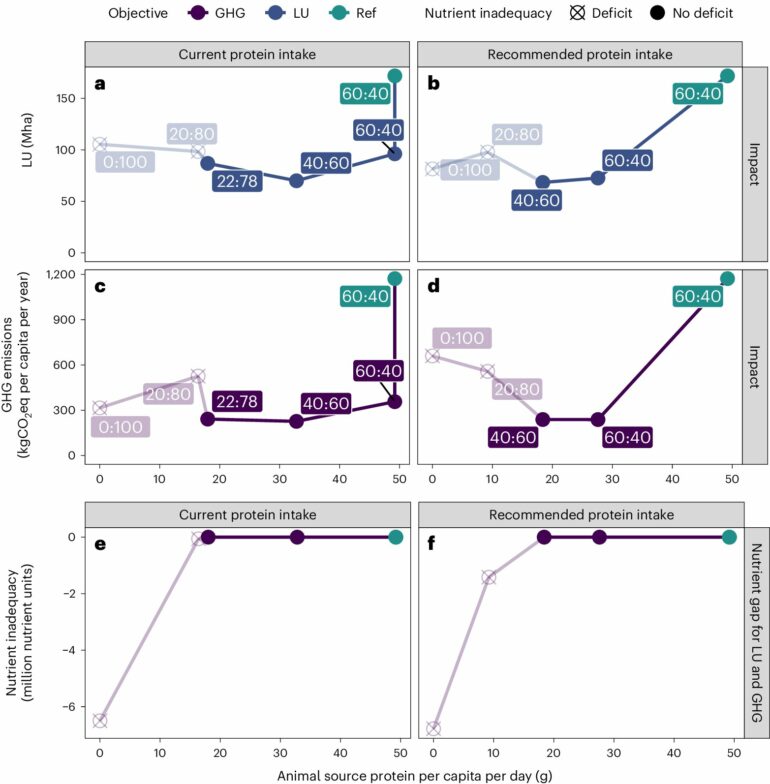Redesigning the European food system will reduce agricultural land by 44% while dramatically reducing greenhouse gas emissions from agriculture by 70%. This reduction is possible with the current consumption of animal protein. If we also reduce the amount of animal protein we eat, replacing it with plant-based protein, land use could be reduced by 60% and emissions by 81%.
These are the remarkable results of model calculations by Ph.D. candidate Wolfram Simon. He is conducting his research at the Department of Farming Systems Ecology at Wageningen University & Research. The study was recently published in Nature Food.
“We combine two approaches: circular agriculture (reusing residue streams and preventing waste) and the protein transition (increased consumption of plant protein as a replacement for animal protein). We also factored in the healthiness of the food.
“For example, if you were to eat a completely vegan diet, you would have a higher risk of vitamin B12 and omega-3 fatty acid deficiencies. That needs to be compensated for, which has implications for the food system.
“We modeled 18 scenarios to model the protein transition in the European food system. Using this holistic circular food systems modeling approach is quite unique and challenging. I spent most of my Ph.D. time developing the optimization model (called CiFoS),” says Simon.
Optimal ratio between animal and plant-based
A transition to a fully plant-based diet is often thought to be best for the planet. However, Simon’s calculations show that this is not necessarily the case. There is a certain optimum for animal consumption, which is 40% animal protein (instead of the current 60%).
This is partly due to the nutrients that animal products can provide. Below 18 grams of animal protein, deficiencies occur. Incidentally, these can be compensated by taking supplements and fortification of diets. But if you don’t take supplements or fortification, land use and greenhouse gas emissions go back up from the optimum to solve the deficiencies.
“Moreover, animals are recyclers in the system. They can recycle nutrients from human-inedible parts of the organic waste and by-products in the food system and convert them to valuable animal products,” Simon says.
An optimal food system looks very different from today’s agriculture. We need a different consumption pattern. For example, we now eat more protein than is necessary (and healthy).
“You might expect that reducing protein consumption would greatly impact sustainability, but that was not the case in our study. The biggest contribution comes from consuming protein sources with a lower environmental impact and redesigning agricultural production.
“Grow crops in places that yield the most and have an ideal climate and fertile soil, and less in places where production conditions are difficult due to the harsher growing conditions.
“Avoiding organic waste as much as possible and reusing all residue streams as animal feed or crop fertilizers is essential. In addition, minimizing transport makes for improvement,” says Simon.
Less beef, more chicken
Although achieving dramatically more sustainable food systems with the same amount of total animal protein is possible, the composition of protein sources in diets changes strongly. More chicken and fish, less beef, dairy and eggs. This is because cattle farming requires a great deal of land and produces a lot of greenhouse gas emissions (methane). Reducing the share of this sector in agriculture ensures greater sustainability.
Reducing animal consumption makes a further contribution to sustainability. An important way to achieve this is to drastically increase pulses’ acreage, especially soybeans, where climatically possible. These have a high protein content and contain many essential amino acids. The crop can fix atmospheric nitrogen, reducing the nitrogen application from synthetic nitrogen fertilizers. Grains and dairy remain essential sources of protein in diets.
Simon says, “This research is useful for setting long-term objectives. When you think about changes in the production system and nutrition, what are the best strategies and direction of change to achieve greater sustainability?
“We want to offer ideas for redesigning the food system and quantify and test the impact of the proposed measures, such as circularity and protein transition. Government and public agencies can then make more informed decisions to redesign the current food system to reduce environmental impacts.”
More information:
Wolfram J. Simon et al, Circular food system approaches can support current European protein intake levels while reducing land use and greenhouse gas emissions, Nature Food (2024). DOI: 10.1038/s43016-024-00975-2
Provided by
Wageningen University
Citation:
Circular food systems found to dramatically reduce greenhouse gas emissions, require much less agricultural land (2024, June 21)



